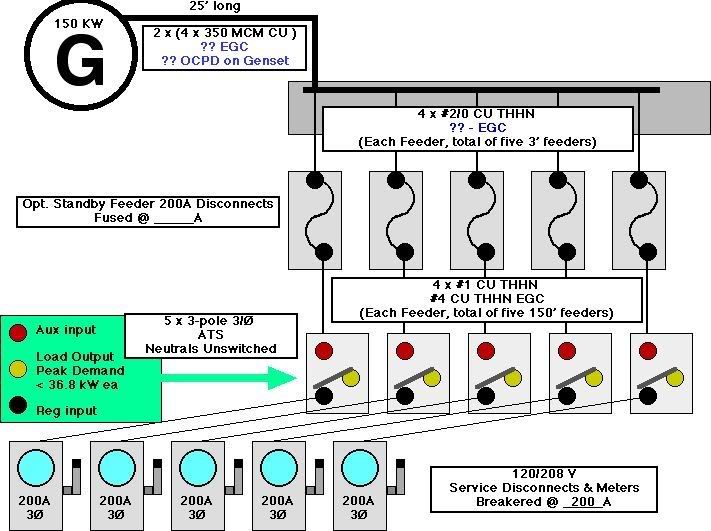Design Electric Inc.
Member
- Location
- Near Tampa Florida
I'm a little confused in designing / installing the GEC and the EGC to avoid a parallel Ground Fault Path on a 150 KW Genset ( w/ OCP).
Here's the senerio:
1. Facility has 5 - 3PH 200 A Meters/ Services feeding 5 tennant spaces.
2. 150 KW Genset w/ Main Breaker.
3. 5 - Exterior Mounted 200 A Fusible Disconnects.
4. 5 - Interior Mountred ATS's.
Here's my question.
Since the normal power nuetral is bonded at the Grounding Electrode at the main service ( 1000 Ft away) I will need to avoid any parallel Ground Fault Path when in Emergency Mode ( or normal mode for that matter).
I've installed EGC's w/ the feeders installed between ATS's and Fusable Disconnets ( S/N's on both), sized per Fuses in the Emergency System's Disconnects.
These disconects are feed from tap conductors in a wireway beneith them, tapped from parrallel 350's from the Genset w/ OCP.
I understand the nuetral bond with-in the genset must be removed.
Finally my issue:
1. Am I correct in assuming I do not need a GEC in this EMER system?
2. Am I correct in assuming that after disconnecting the Nuetral bond in the GenSet, I simply install EGC back to the genset and bond the frame, relying on the normal power GEC for Ground Fault Protection when in Emergency Mode?
3. And if so, how do I size the EGC from the Genset to the Wireway feeding the Disconects.
These are Art. 702 Loads
Here's the senerio:
1. Facility has 5 - 3PH 200 A Meters/ Services feeding 5 tennant spaces.
2. 150 KW Genset w/ Main Breaker.
3. 5 - Exterior Mounted 200 A Fusible Disconnects.
4. 5 - Interior Mountred ATS's.
Here's my question.
Since the normal power nuetral is bonded at the Grounding Electrode at the main service ( 1000 Ft away) I will need to avoid any parallel Ground Fault Path when in Emergency Mode ( or normal mode for that matter).
I've installed EGC's w/ the feeders installed between ATS's and Fusable Disconnets ( S/N's on both), sized per Fuses in the Emergency System's Disconnects.
These disconects are feed from tap conductors in a wireway beneith them, tapped from parrallel 350's from the Genset w/ OCP.
I understand the nuetral bond with-in the genset must be removed.
Finally my issue:
1. Am I correct in assuming I do not need a GEC in this EMER system?
2. Am I correct in assuming that after disconnecting the Nuetral bond in the GenSet, I simply install EGC back to the genset and bond the frame, relying on the normal power GEC for Ground Fault Protection when in Emergency Mode?
3. And if so, how do I size the EGC from the Genset to the Wireway feeding the Disconects.
These are Art. 702 Loads


